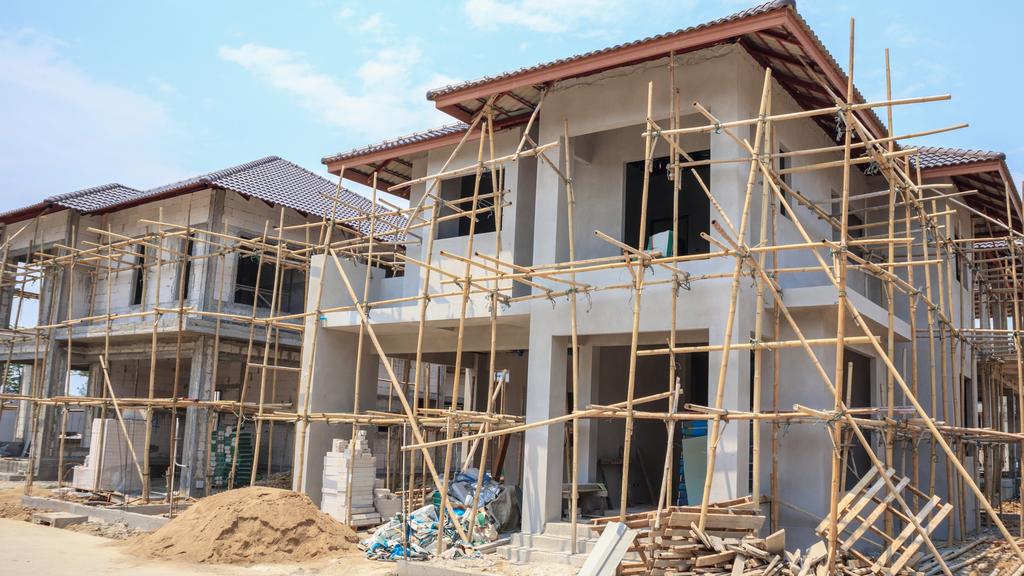Government efficiency needed in construction as building costs start to ease

Increased hurdles in getting approvals are driving up construction costs, which threatens the viability of affordable housing, despite a further easing in building materials costs.
Governments have been urged to back reforms in the construction industry to keep costs in check and boost efficiency to ensure the nation’s ambitious housing targets are met.
Private developers are facing steep competition for resources from major infrastructure projects, which is making it tough for them to secure top-tier builders for both housing and commercial projects.
Forecasters expect the non-residential downturn to continue, with Oxford Economics Australia forecasting that new projects slipped 4 per cent to $51.87bn over the 12 months to June 30.
The research house said the slide was expected to continue into this financial year as private investment slowed, with activity patchy as higher borrowing and construction costs continued to drag on the sector.
While the fall-off would be cushioned by a surge in warehouse construction, it warned that offices and retail had been hit by a series of structural headwinds, including difficulty in getting precommitments from office tenants and the big squeeze on household budgets, which was hurting malls.
Investment group MA Financial, which is one of a growing number of fund managers forging deep into private credit, said that government inefficiencies were playing a big role in pushing construction prices up, but the cost of building materials was no longer a significant headwind for the sector.
High costs were making it hard to build affordable housing, with many developers pivoting towards luxury projects where it was possible to recoup costs and turn a profit.
This was likely to make the Albanese government’s target of building 1.2 million homes by 2030 more challenging.

Governments face mounting pressure to back reforms in the construction industry to keep costs in check and boost efficiency.
MA Financial’s head of real estate credit Drew Bowie said governments needed to create more efficient approval and permitting processes through better resourcing or offshoring non-critical tasks.
“We need to look at how we improve turnaround times on DA, on construction certificates and all the paperwork that needs to be done between starting a project and completing it,” he said.
“There’s so much paperwork, so many checks and balances, which are appropriate, but it’s just paperwork, which means it’s just manpower, which means you can address it through more efficient processes.”
Mr Bowie said it was now common for a developer to be asked to address more than 100 conditions for one development application, which resulted in significant expenses.
“Most of those conditions require a third party consultant, which equals time and that means more money,” he said.
“Now, I’m not suggesting the government would do this or should do this, but organisations often have offshore processes to get a 24-hour turnaround, which are creating efficiencies. We’ve got to look at how the government plays its part in creating more efficiencies to ensure we get more built.”

MA Financial’s head of real estate credit Drew Bowie.
Analysis by MA Financial of Australian Bureau of Statistics data shows that building materials price rises had moderated, with timber down by 0.5 per cent in the 12 months to the March quarter. Ceramic and cement products increased 1.8 per cent and plumbing products were down 0.4 per cent. Steel was up 0.8 per cent in the period, compared to 13.1 per cent in the third quarter of 2021.
Supply chain disruptions between 2021 and 2022 resulted in construction costs surging by more than 15 per cent, the highest increase since the first OPEC oil price shock in 1973-74.
“Material costs are not having a significant bearing on project delivery starts anymore, with inefficiencies more of a concern for the sector,” Mr Bowie said. “We recognise that construction is only one element of project risk. This normalisation of construction cost increases provides a greater level of confidence for project builders, for developers and lenders in unlocking this housing supply crisis.”
Mr Bowie said that inefficiencies had worsened since the pandemic because working from home had resulted in a blowout in the time it took to get projects off the ground. The ABS reported that the total number of dwellings approved was up 5.5 per cent in May, which took the 12-month increase to 163,759 – the lowest level in a decade.
“I hear at site meetings week in week out whereas a group used to turn something around in a week, it is now two months to do the same thing. That has a compounding effect on finance charges,” he said. “Interest rates have gone up and that means finance costs have gone up and if we’re now delayed by three, six months, just through efficiency in dealing with the government, then that has a huge impact on new supply.”
Mr Bowie said the inefficiency was likely to affect the viability of affordable housing projects. “Costs don’t typically discriminate as to what is being built. You would have to sell for $17,000 a metre to be able to recoup your construction costs, your finance costs, and your land acquisition or your project costs,” he said.
“It’s hard to make a project viable if the market can only pay $12,000 a metre. That is why we are seeing a push into the luxury end of the market because certainly in Sydney it is selling for prices like $100,000 a metre. It’s easy to build for that.”

Oxford Economics Australia estimates that new projects fell 4 per cent to $51.87bn over the 2024 financial year.
Mr Bowie said that if construction workers received strong pay rises, fewer projects by private and government sectors getting off the ground.
“We’re not going to have new projects commence, certainly in the private world, if wages go up that much. Infrastructure projects might still go ahead, but we expect even those to start to taper off,” he said.
“We’ve got plenty of new infrastructure builds under way or well advanced across the country, but we are not seeing new projects starting at the same rate, which will free up labour.”
New enterprise agreements in Queensland will result in wages increasing in the sector by 26 per cent between 2023 and 2027. NSW is also expected to see a sharp rise in labour costs, with trade unions wanting a 28 per cent wage rise over three years and 8 per cent upfront. Negotiations in Victoria are expected to produce similar results.
The sector is also dealing with reports of CFMEU illegal activity, which developers said had become entrenched and was hampering their activities.
Australian Construction Industry Forum executive director Dr James Cameron said there had to be “zero tolerance” for flouting the rule of law in construction. “Productivity growth in the industry has lagged other industries for decades, and the industry needs to attract hundreds of thousands of new workers,” he said.
Mr Cameron said the current situation was “difficult” but was an opportunity for “widespread reform and renewal, and to improve the culture of the industry”.







